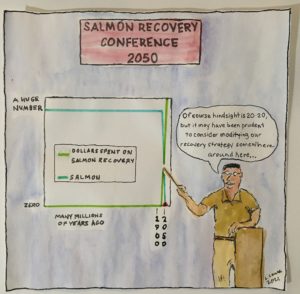Markets Prevail; Hatcheries Fail
 million. Far fewer people lived in California during the 1861-62 floods. In December 1861 and January 1862 some 35 inches of rain fell in San Francisco, and similar downpours hit surrounding areas. Most of the Central Valley was underwater. And then from the fall of 1862 until 1865 severe drought followed. Picture at right is downtown Sacramento.
million. Far fewer people lived in California during the 1861-62 floods. In December 1861 and January 1862 some 35 inches of rain fell in San Francisco, and similar downpours hit surrounding areas. Most of the Central Valley was underwater. And then from the fall of 1862 until 1865 severe drought followed. Picture at right is downtown Sacramento.Today, from a comprehensive point of view, the Washington salmon fishery almost certainly makes a negative contribution to net national product. The opportunity costs of the socially unnecessary resources employed there, plus the socially unnecessary costs of governmental research, management, and regulation, are greater than the total value added by all the labor and capital employed in the fishery.
Government stubbornness imperils salmon… While the Brown administration declared a drought state of emergency in California, the federal Coleman fish hatchery plans to continue business as usual, releasing baby salmon into almost certain death in the drought-stricken Sacramento River.
Planned releases follow previous releases of over 750,000 baby salmon in the last six weeks, ignoring warnings from salmon advocates that the fish are unlikely to survive. Federal officials overseeing the controversial releases admit conditions are very bad for salmon, but insist on releasing the fish at the hatchery anyway. …
The state-run Feather River and Mokelumne hatcheries have similar issues, so they release their fish downstream with greatly improved survival and adult returns. The federal Coleman hatchery continues to ignore these accomplishments. (Source.)
Why should the Federal government own and operate dams and hatcheries in California? Just one federal agency, the Bureau of Land Management, owns and runs 15% of California land. Even those who believe government should own land and water resources, could reasonably question why the federal government should continue struggling to manage land and marine natural resources in California. Here is the BLM page on its California operations. Under “Wildlife and Fisheries” is an interesting BLM list of projects that though it includes a moose and a lizard, it doesn’t include fish, oysters, or any marine natural resource. Not a priority, I guess.You can click on the “Endangered and Threatened Species in California” which is supposed to connect to a U.S. Fish and Wildlife site. I tried the link and was directed to a help desk (update! Link works now].
The Cato Institute’s Downsizing Government website looks at various Department of the Interior programs including the Department of Fish and Wildlife. The focus is on reforming federal land management.
FWS budget outlays were about $3.1 billion in fiscal 2011.45 About $1.2 billion of that spending was for grants to state and local governments for fish and wildlife habitat improvement programs.46 There is little reason for the FWS to be involved in these state and local programs, as it is simply acting as a financial middleman.
Of the remaining $1.9 billion in the FWS budget, about $500 million is spent managing wildlife refuges and marine monuments, about $600 million is spent on endangered species and various habitat programs, and about $150 million is spent on fish hatcheries and aquatic habitat programs…. (Source.)
Why not transfer ownership of federal dams, hatcheries and other federally owned and (mis)managed operations to private, community, or state of California management? Privately-owned facilities would pay taxes and respond to market incentives. Prices would influence direct the flow water resources to energy production, irrigation, recreation, and encouraging salmon and other wildlife.

